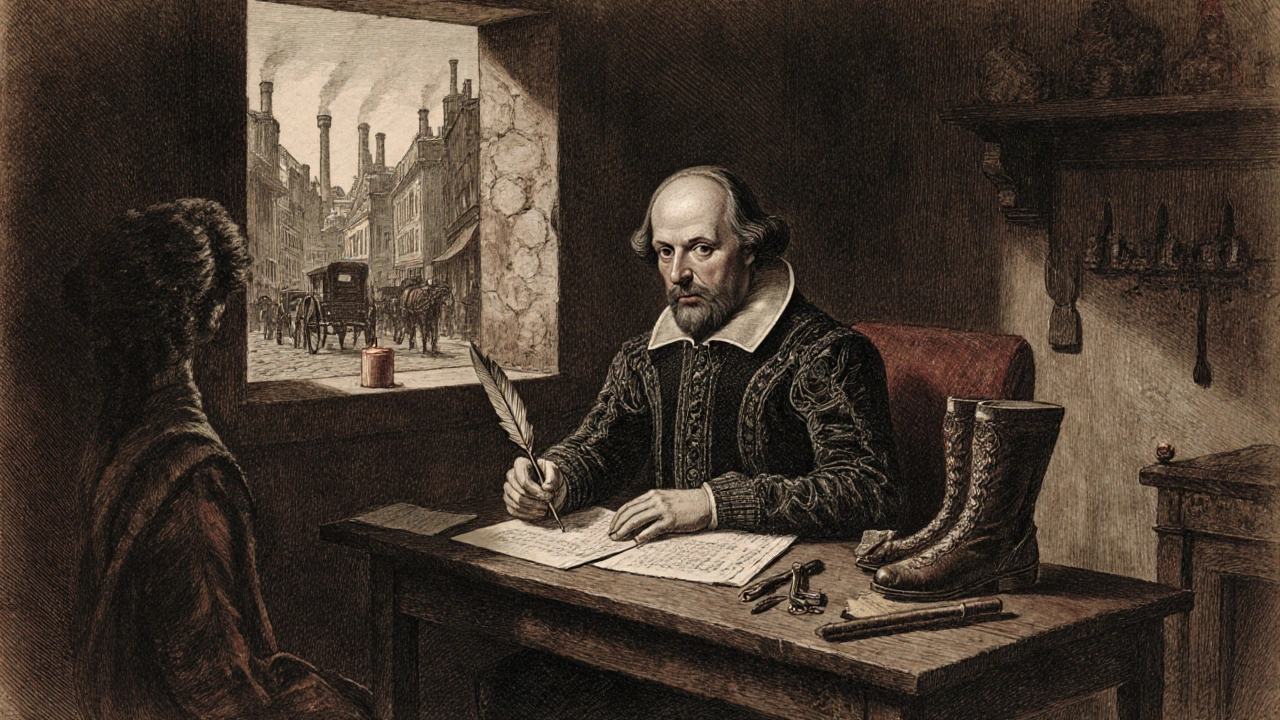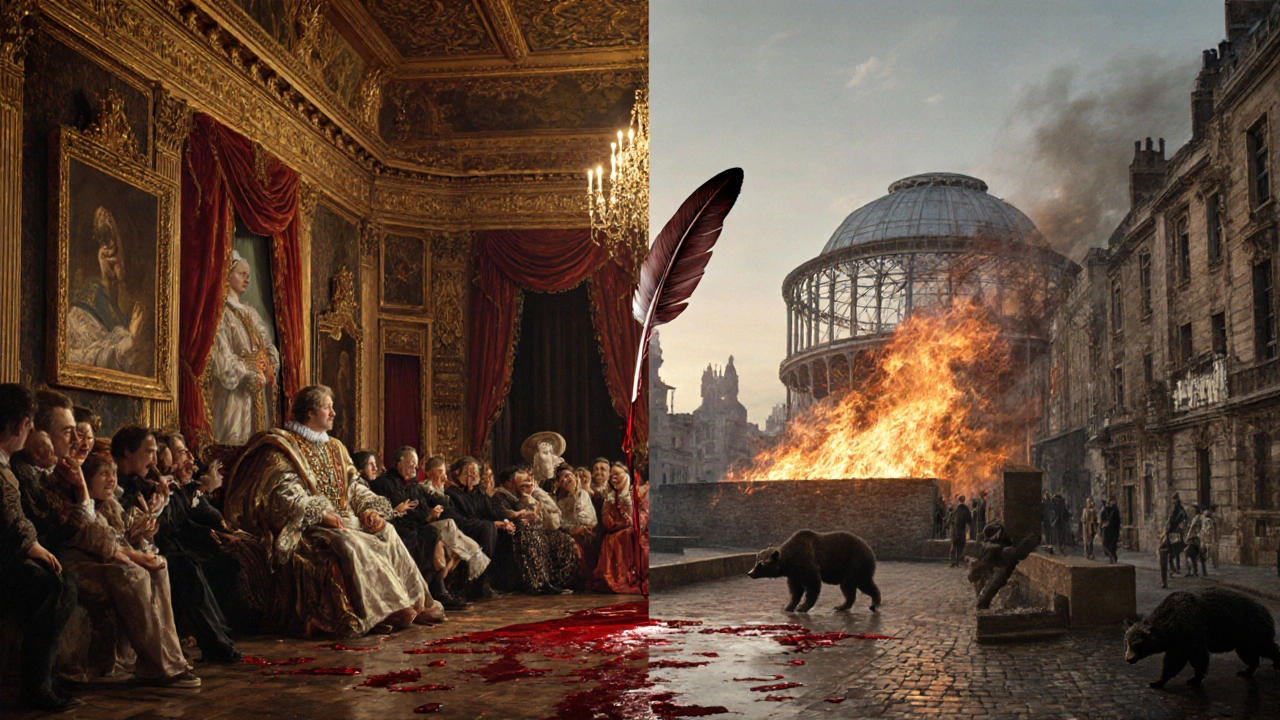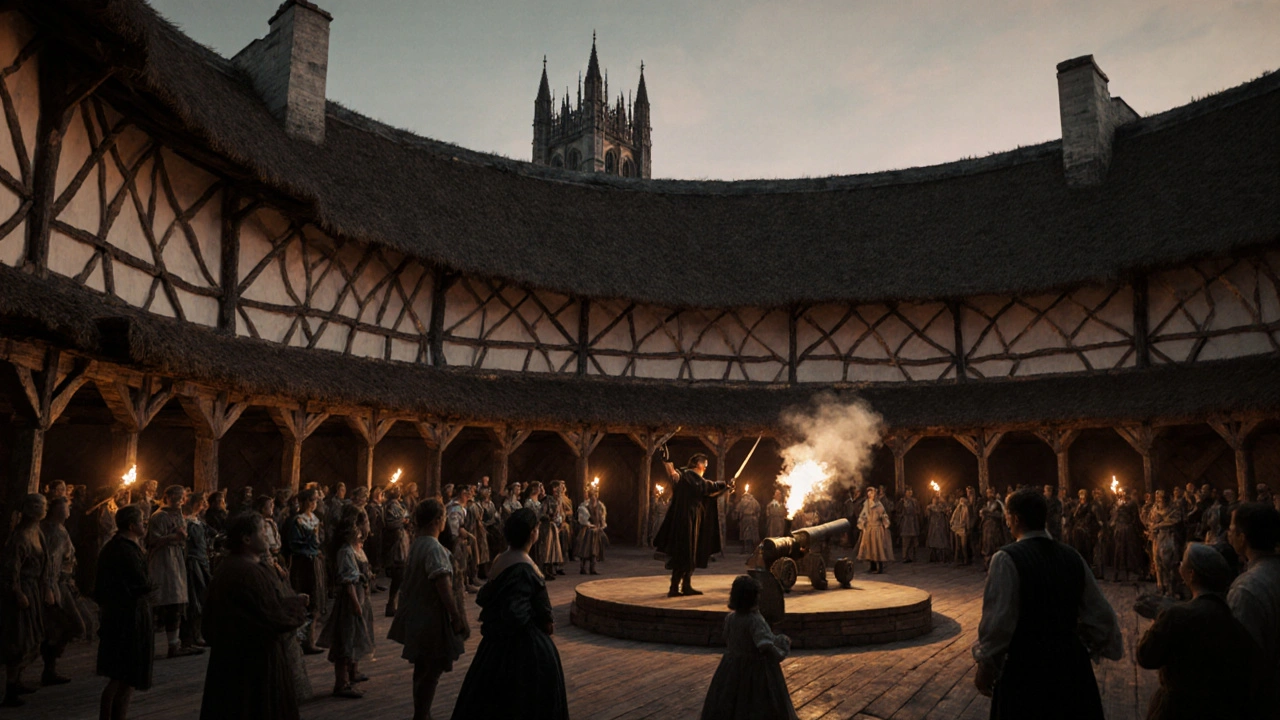Walk down Bankside today, and you’ll see tourists snapping photos in front of a wooden circle with open skies above. It looks like a stage set. But 400 years ago, this was where Shakespeare’s words came alive-shouted over cheers, drowned by rain, lit by torchlight. This isn’t a replica. It’s a resurrection. And it’s just one piece of the real Shakespeare in London.
Where Shakespeare Lived
Shakespeare didn’t grow up in a castle. He moved to London around 1585, probably in his mid-twenties, chasing work. Back then, the city was a mess of narrow alleys, open sewers, and overcrowded tenements. He lived in several places, but the most documented is a rented room near St. Helen’s Bishopsgate, just north of the River Thames. Not far from where the Bankside Power Station stands now, he walked past butchers, brewers, and street preachers.
He wasn’t rich. Records show he paid 20 shillings a year for rent-about what a skilled laborer made in three weeks. His neighbors? Actors, playwrights, printers, and con artists. One of his landlords, Christopher Mountjoy, was a wig maker. Shakespeare later got tangled in a lawsuit over Mountjoy’s daughter’s dowry. The court transcript from 1612 is one of the few real glimpses we have of him talking.
He didn’t stay in one place long. He moved to Southwark by the early 1590s, right across the river from the City of London. That’s where the theatres were. The authorities hated them. Too noisy. Too rowdy. Too many people gathering. But the crowds kept coming. And Shakespeare? He was becoming one of the biggest draws.
The Globe Theatre: More Than a Stage
The Globe wasn’t just a theatre. It was a business. Built in 1599 by Shakespeare’s acting company, the Lord Chamberlain’s Men, it was made from the timbers of their old playhouse, The Theatre, which they’d dismantled overnight after a rent dispute. They moved the wood across the Thames under cover of darkness-like thieves, but for art.
It was a 20-sided polygon, about 100 feet across, with no roof over the center. That’s why you’ll see paintings of audiences holding umbrellas. The groundlings-people who paid a penny-stood in the yard, right in front of the stage. They were the ones who laughed loudest, threw oranges, and shouted back at the actors. The nobles sat in the covered galleries, paying up to six pennies for a cushioned seat.
Shakespeare didn’t just write for the Globe-he owned it. He held a 12.5% share. That made him a shareholder, not just a writer. That’s why he could afford to buy New Place, the biggest house in Stratford-upon-Avon, in 1597. The Globe paid his bills.
On June 29, 1613, during a performance of Henry VIII, a cannon fired for effect. A spark hit the thatched roof. The whole thing burned down in an hour. No one died. But the Globe was gone. It was rebuilt the next year, this time with a tiled roof. And Shakespeare? He’d already retired to Stratford by then.

Stages Beyond the Globe
Shakespeare didn’t only perform at the Globe. London had at least a dozen playhouses in the 1590s. The Curtain, the Rose, the Blackfriars-each had its own crowd, its own vibe.
The Rose, built in 1587, was where Tamburlaine first shocked audiences with its grandeur. Shakespeare’s early plays likely played here before the Globe opened. The Curtain, just a few minutes’ walk away, hosted Henry V in 1599. And the Blackfriars? That was different. Indoor. Lit by candles. Smaller. Quieter. Wealthier. This is where Shakespeare’s later, darker plays-Macbeth, King Lear, The Tempest-were staged after 1608. The audience sat in chairs. No standing. No shouting. Just hushed awe.
Shakespeare wrote for all of them. He knew how to adjust his language. The Globe needed big gestures, loud lines, and punchy rhymes. The Blackfriars? Subtlety. Silence. Nuance. He was the first playwright who understood that the space changed the story.
Shakespeare’s London: A City of Contrasts
Shakespeare’s London wasn’t just theatres. It was a city of extremes. On one side, the Tower of London loomed with its executions and prisoners. On the other, the Royal Court dazzled with masques and silk. He moved between both.
His patrons included Queen Elizabeth I and then King James I. James even made Shakespeare’s company the King’s Men in 1603. That meant royal performances, fancy clothes, and a steady paycheck. But he also wrote for the masses. His plays had jokes about constables, bawdy puns about servants, and references to London’s most famous pubs-like the Tabard Inn, where Chaucer’s pilgrims gathered decades before.
He watched the plague close theatres in 1593 and 1603. He saw the Gunpowder Plot in 1605, when someone tried to blow up Parliament. You can hear the fear in Macbeth. He lived through the rise of the printing press, the first newspapers, and the first English dictionary. He saw the city grow from 200,000 people to nearly half a million.
And he wrote it all down-not as history, but as human drama. His characters weren’t kings and queens in marble. They were people who lied, cheated, loved, and lost. Falstaff? He was a drunken knight who stole from taverns. Othello? A general who trusted too much. Hamlet? A prince who couldn’t decide if he should act or just scream into the void.

What’s Left Today
Shakespeare’s original Globe is gone. But the modern reconstruction, opened in 1997, sits just 230 yards from the original site. It’s built using 16th-century techniques: oak beams, hand-hewn timbers, thatch roof made from reeds. They even use candles for lighting during evening shows. You can walk the yard, stand where groundlings stood, and feel the same rush of a crowd reacting to a line.
Other places still hold his ghost. The Southwark Cathedral, just down the road, is where his brother Edmund was buried in 1607. You can still see the plaque. The Church of St. Saviour’s (now Southwark Cathedral) was the nearest place of worship to the Globe. Shakespeare’s company paid for the repair of its bell tower in 1614.
And then there’s the British Library. They hold the First Folio-the 1623 collection of 36 plays, published seven years after his death. Without it, half his work would be lost. Only 233 copies survive. One is on display in the library’s permanent exhibition. You can see the ink smudges, the corrections in the margins, the fingerprints of readers from 400 years ago.
Why It Still Matters
Shakespeare didn’t invent English. He didn’t even invent drama. But he gave it shape. He gave it soul. He took stories from history, myth, and gossip-and made them about people you recognize. The jealous husband. The ambitious daughter. The fool who sees the truth.
His language? It’s still alive. We say ‘break the ice,’ ‘heart of gold,’ ‘wild-goose chase,’ ‘green-eyed monster.’ All of them came from him. He didn’t just write plays. He wrote the dictionary of modern emotion.
When you stand in the Globe today, you’re not just watching a show. You’re standing where the first modern storyteller made his mark. The same stage that echoed with Romeo and Juliet now echoes with schoolchildren, tourists, and locals. The same questions still hang in the air: Will he forgive her? Should he kill him? Can love survive betrayal?
Shakespeare didn’t need fancy sets. He didn’t need CGI. He just needed words. And people. And a stage under the open sky.
Did Shakespeare write all his plays alone?
Most scholars believe Shakespeare wrote the majority of his plays alone, but he often collaborated. For example, Henry VIII and The Two Noble Kinsmen were co-written with John Fletcher. Playwrights in that era frequently worked together, especially when producing multiple plays per year. The idea of a lone genius writing in isolation is a modern myth.
How did Shakespeare become so famous so quickly?
He was in the right place at the right time. London’s population exploded in the 1590s, and theatre was the Netflix of its day. Shakespeare wrote fast, wrote well, and acted in his own plays. He also owned part of the Globe, so he had control over where his work was staged. His plays mixed comedy, tragedy, politics, and romance in ways no one else had done before.
Was Shakespeare rich?
Yes, by the standards of his time. He earned money from acting, playwriting, and theatre ownership. By 1597, he bought New Place, the second-largest house in Stratford. He also invested in land and tithes. He wasn’t a noble, but he made enough to retire comfortably at 49. His wealth came from being both an artist and a businessman.
Why was the Globe Theatre built outside the City of London?
The City of London’s authorities hated theatres. They thought they encouraged crime, disease, and idleness. So theatres were pushed to the edges-Southwark, across the Thames. That area was outside city control, near the bear-baiting pits and brothels. It was the entertainment district. The Globe’s location wasn’t an accident-it was a necessity.
Can you visit Shakespeare’s original home in London?
No. His London homes have been lost to time-fires, redevelopment, and neglect. The only surviving house linked to him is New Place in Stratford-upon-Avon, which was demolished in the 17th century. But the site is now a garden managed by the Shakespeare Birthplace Trust. In London, you can visit the reconstructed Globe, Southwark Cathedral, and the British Library’s First Folio display-all places that connect you to his real life.
